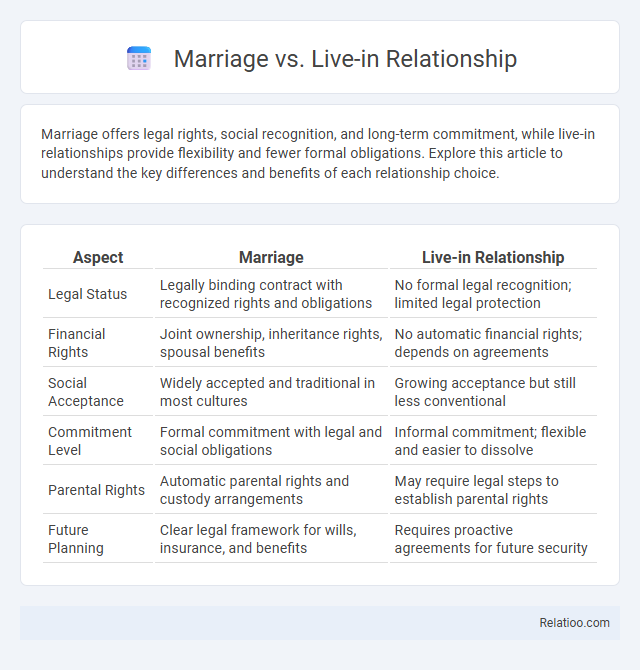Marriage offers legal rights, social recognition, and long-term commitment, while live-in relationships provide flexibility and fewer formal obligations. Explore this article to understand the key differences and benefits of each relationship choice.
Table of Comparison
| Aspect | Marriage | Live-in Relationship |
|---|---|---|
| Legal Status | Legally binding contract with recognized rights and obligations | No formal legal recognition; limited legal protection |
| Financial Rights | Joint ownership, inheritance rights, spousal benefits | No automatic financial rights; depends on agreements |
| Social Acceptance | Widely accepted and traditional in most cultures | Growing acceptance but still less conventional |
| Commitment Level | Formal commitment with legal and social obligations | Informal commitment; flexible and easier to dissolve |
| Parental Rights | Automatic parental rights and custody arrangements | May require legal steps to establish parental rights |
| Future Planning | Clear legal framework for wills, insurance, and benefits | Requires proactive agreements for future security |
Understanding Marriage and Live-in Relationships
Marriage legally binds two individuals, offering social, financial, and legal protections that live-in relationships often lack, though the latter provides greater flexibility and personal freedom. Understanding marriage involves recognizing its formal commitment, shared responsibilities, and societal expectations, while live-in relationships emphasize cohabitation without legal formalities, allowing couples to test compatibility before making long-term decisions. Your choice between these arrangements depends on your values, long-term goals, and need for legal security versus personal autonomy.
Legal Recognition and Rights
Marriage provides comprehensive legal recognition and rights, including inheritance, tax benefits, healthcare decisions, and spousal support. Live-in relationships, while gaining some legal protections, often lack the full spectrum of rights granted to married couples, making legal disputes more complex. Your rights in a romance without formal recognition remain limited, emphasizing the importance of legally binding agreements to protect personal and financial interests.
Social Acceptance and Cultural Norms
Marriage remains the most socially accepted and culturally endorsed form of relationship across many societies, often linked to legal rights and family recognition. Live-in relationships face mixed social acceptance depending on regional cultural norms, with some communities viewing them as progressive while others consider them unconventional or taboo. Your choice between marriage, live-in partnership, or romance can significantly influence social interactions and acceptance based on prevailing cultural values and societal expectations.
Commitment and Stability
Marriage offers a legally binding commitment providing long-term stability through formal recognition and societal support. Live-in relationships emphasize flexibility and personal freedom but often lack the legal protections and societal validation associated with marriage. Romance involves emotional connection and attraction, which can exist independently of the structural commitment found in either marriage or live-in arrangements.
Financial Implications and Responsibilities
Marriage often entails shared financial responsibilities such as joint asset management, tax benefits, and legal obligations for debts and expenses, providing a structured economic partnership. Live-in relationships typically lack formal financial commitments, leaving partners to manage expenses independently or through informal agreements without legal protections. Romance without cohabitation usually incurs separate financial responsibilities, with each individual maintaining personal expenses and minimal economic interdependence.
Emotional Security and Well-being
Marriage often provides a structured framework that enhances emotional security and long-term well-being through legal and social recognition. Live-in relationships offer flexibility and personal freedom, though they may lack the societal support that contributes to emotional stability. Your choice between marriage, live-in, or romance impacts your emotional health, as commitment levels and social acceptance vary significantly.
Impact on Children and Family
Marriage provides legal and social stability that often benefits children by ensuring rights related to inheritance, custody, and support, fostering a structured family environment. Live-in relationships, while increasingly accepted, may lack formal legal protections, potentially creating uncertainty for children regarding parental responsibilities and security. Romance alone, without cohabitation or formal commitment, typically offers minimal impact on family structure and child well-being due to the absence of sustained parental involvement or legal recognition.
Flexibility and Freedom of Choice
Marriage offers a structured commitment often with societal and legal obligations, while live-in relationships provide greater flexibility and freedom of choice without formal ties. Romance thrives in both settings but can flourish more dynamically in live-in arrangements where partners navigate boundaries and expectations together. Your personal preference for stability or adaptability influences the best path for emotional fulfillment.
Societal Perceptions and Taboos
Marriage is traditionally viewed as the socially acceptable and legally recognized foundation for family life, often associated with lifelong commitment and societal stability. Live-in relationships challenge conventional norms by offering couples cohabitation without formal legal ties, frequently encountering skepticism or stigma in conservative societies. Romance outside these frameworks is generally accepted but can face taboos depending on cultural, religious, and generational values influencing public opinion and social acceptance.
Choosing What’s Right: Key Considerations
Choosing between marriage, live-in relationships, or romance depends on your personal values, long-term goals, and emotional needs. Marriage offers legal and social recognition with benefits like financial security and shared responsibilities, while live-in relationships provide flexibility and less formal commitment, ideal for those prioritizing independence. Understanding your priorities and communication with your partner ensures you select the path that aligns best with your lifestyle and aspirations.

Infographic: Marriage vs Live-in Relationship
 relatioo.com
relatioo.com